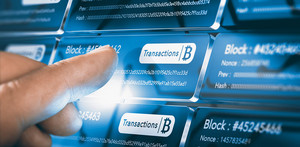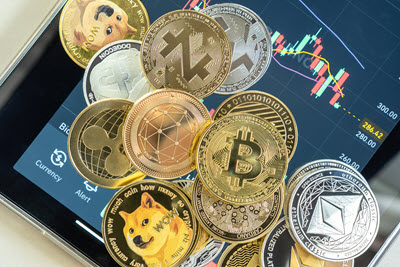Bitcoin purchase request
How do cryptoassets work?

Although certain cryptoassets are used as a form of payment or means of exchange, they aren’t legal tender in Canada.
The Canadian dollar is the only legal tender in the country, although some types of transactions can be settled in another currency (e.g., the U.S. dollar) if both parties to the transaction agree to it.
The AMF reminds investors that transactions involving cryptoassets are not covered by deposit protection.
What are cryptoassets?
Cryptoassets are digital assetsIntangible assets whose value is based on supply and demand. that use cryptography (a method of securing data), a peer-to-peer networkA computer network where the computers are connected to one another directly, which means information is sent between them without going through a central server. and a digital distributed ledgerA distributed ledger uses stand-alone computers (referred to as “nodes”) to record, share and synchronize transactions. system to record transactions.
Bitcoin is the most important and best-known cryptoasset.
- Unlike currency that is legal tender, Bitcoin is not issued by a central bank or government
- Bitcoin is generally exchanged when a transaction between two parties is added to the blockchainA secure, distributed database that stores transactions between users, from the date of its creation, in a chronologically ordered sequence of blocks that are linked together.
- Trading on the blockchain is conducted without the involvement of an intermediary

There are many other types of cryptoassets, including Ether (Ethereum), XRP (Ripple) and Litecoin (Litecoin).
None are legal tender.
Stablecoin (value-referenced cryptoasset)
A stablecoin (value-referenced cryptoasset) is a digital asset that is designed to achieve greater value stability than other cryptoassets (e.g., Bitcoin or Ether). There are different types of stablecoins, including some that are pegged to the value of an asset such as a currency (e.g., the U.S. dollar) or to a basket of assets and that are backed by a reserve whose value, in many cases, is expressed in fiat currency (e.g., U.S. dollars). In principle, under certain conditions, an investor should be able to redeem this type of stablecoin for the asset it is pegged to. Other stablecoins use algorithms that trigger purchases and sales to keep their value stable. Like Bitcoin, stablecoins are not legal tender.
Certain stablecoins have experienced sudden, steep declines in value, failing to deliver on their promise of stability. While they promise less volatility than other cryptoassets, stablecoins are still risky investments.
Public keys and private keys
A digital wallet used for the exchange and custody of cryptoassets is protected by two keys consisting of strings of letters and digits.
- The first string, called the “public” key, is used to identify your account on the network and can be shared for the purpose of receiving cryptoassets. This key allows you to, among other things, verify the number of cryptoasset units stored in your account.
- The second, called the “private” key, must be kept secret. It is like a secret code that allows you to perform transactions in your account. When you use a cryptoasset trading platform, the private key is held for you by the platform. You should know what safeguards the platform uses to keep your cryptoassets safe.
Check whether the platform is registered with the AMF
A list of registered cryptoasset trading platforms is also available in the Registers section of the AMF website.
While its application for registration is being reviewed, a platform must enter into a pre-registration undertaking with the AMF in order to continue operating in Québec. The undertaking provides that the platform agrees to comply with terms and conditions that are intended to protect investors and generally consistent with current requirements for registered platforms.
Blockchain technology

Blockchain is a decentralized information storage and transmission technology that operates without a central control body. Blockchain technology is primarily used in the field of cryptoassets: It records and updates the transactions of cryptoassets for all participants securely using cryptographic checks.
A blockchain is similar to a digital accounting record or ledger that is replicated on a network of computers (nodes) rather than kept at a single location. In the context of a blockchain, a node is a computer that holds a copy of the blockchain and that maintains it through interactions with other users. Each node ensures compliance with the blockchain consensus rules required for system integrity. When a cryptoasset transaction is recorded on the blockchain, a peer-to-peer network validates the transaction and adds it to a list of pending transactions that forms a block.
A block is the digital equivalent of a page of an accounting record and cannot be altered. Once a block is complete, it is linked in chronological order to the previous block in the chain. This action is irreversible and visible to everyone on the system. Since a network of computers validates and maintains the blockchain, it is practically impossible to counterfeit the information that has been stored.
There are several types of blockchains, and some cryptoassets have their own protocols and rules for their blockchains. This is the case, for example, with Bitcoin and Ether, which use respectively the Bitcoin and Ethereum protocols referred to below.
Proof of work
The people who operate nodes (computers) on the Bitcoin blockchain and validate cryptoasset transactions are called “miners.” Miners are rewarded with Bitcoins and transaction income when they validate and add transactions to the blockchain. This is how new Bitcoins are minted.
For example, if you wish to purchase a Bitcoin (or a fraction), your request will go through the following steps:
You request to purchase a Bitcoin on a trading platform or from another person.
Grouping transactions
The peer-to-peer network user (miner) whose computer first solves a complex mathematical equation groups the pending transactions into a block.
Creating a block
Your transaction request appears on the blockchain and is added to a series of pending transactions.
Validity of the transaction
The block and the solution to the mathematical equation are sent to the network so that the other miners can validate the block with their computers. Your Bitcoin is deposited in your wallet once the validation is completed.
Blockchain update
The blockchain is updated across the whole network.
This validation mechanism is called “proof of work.” Very powerful computers dedicated exclusively to mining activities are required to solve the very complex mathematical equation as quickly as possible. It is practically impossible to mine Bitcoins using a conventional personal computer.
“Mining farms” are usually large spaces housing many computers dedicated to proof-of-work mining of one or more cryptoassets.
For more information, see the page on mining farms
Staking, or proof or stake (Ethereum protocol)
There are other validation mechanisms, including “proof of stake,” which is used by the Ethereum blockchain. Instead of trying to solve a mathematical equation as quickly as possible, cryptoasset holders who want to validate transactions through proof of stake may commit an amount of their cryptoassets (a stake) to third parties acting as validators. Validators combine the stakes of all the holders on the network according to the coded rules in the blockchain's protocol. Validators then compete to produce (validate) the next block of transactions. The winner is chosen based on the amount staked, the time that has elapsed since the staking, and chance. The winner is usually rewarded with cryptoassets.
Some registered cryptoasset trading platforms offer staking as a service to investors who want to generate income from their cryptoassets.
Do you hold cryptoassets on a registered platform that offers a staking service? Staking is an activity that carries many risks. Before you commit money to a stake, take time to:
- Understand that the amount you have staked to the validator could be confiscated or reduced if the validator makes a mistake or incorrectly performs its validation function
- Read the statement describing the risks associated with staking. Find out, among other things, whether the platform reimburses investors for cryptoassets staked and lost owing to the validator’s acts or omissions, how the risks will be mitigated or how losses might be allocated to investors
- Consider that the amount of cryptoassets staked could be blocked during the validation cycle, which means you may not have access to your staked cryptoassets during this period to make a transaction (e.g., sell them), regardless of what happens to their price
- Consider the fees charged by the platform for the staking services.
Proof of work
The people who operate nodes (computers) on the Bitcoin blockchain and validate cryptoasset transactions are called “miners.” Miners are rewarded with Bitcoins and transaction income when they validate and add transactions to the blockchain. This is how new Bitcoins are minted.
For example, if you wish to purchase a Bitcoin (or a fraction), your request will go through the following steps:
Bitcoin purchase request
You request to purchase a Bitcoin on a trading platform or from another person.
Grouping transactions
The peer-to-peer network user (miner) whose computer first solves a complex mathematical equation groups the pending transactions into a block.
Creating a block
Your transaction request appears on the blockchain and is added to a series of pending transactions.
Validity of the transaction
The block and the solution to the mathematical equation are sent to the network so that the other miners can validate the block with their computers. Your Bitcoin is deposited in your wallet once the validation is completed.
Blockchain update
The blockchain is updated across the whole network.
This validation mechanism is called “proof of work.” Very powerful computers dedicated exclusively to mining activities are required to solve the very complex mathematical equation as quickly as possible. It is practically impossible to mine Bitcoins using a conventional personal computer.
“Mining farms” are usually large spaces housing many computers dedicated to proof-of-work mining of one or more cryptoassets.
For more information, see the page on mining farms
Staking, or proof or stake (Ethereum protocol)
There are other validation mechanisms, including “proof of stake,” which is used by the Ethereum blockchain. Instead of trying to solve a mathematical equation as quickly as possible, cryptoasset holders who want to validate transactions through proof of stake may commit an amount of their cryptoassets (a stake) to third parties acting as validators. Validators combine the stakes of all the holders on the network according to the coded rules in the blockchain's protocol. Validators then compete to produce (validate) the next block of transactions. The winner is chosen based on the amount staked, the time that has elapsed since the staking, and chance. The winner is usually rewarded with cryptoassets.
Some registered cryptoasset trading platforms offer staking as a service to investors who want to generate income from their cryptoassets.
Do you hold cryptoassets on a registered platform that offers a staking service? Staking is an activity that carries many risks. Before you commit money to a stake, take time to:
- Understand that the amount you have staked to the validator could be confiscated or reduced if the validator makes a mistake or incorrectly performs its validation function
- Read the statement describing the risks associated with staking. Find out, among other things, whether the platform reimburses investors for cryptoassets staked and lost owing to the validator’s acts or omissions, how the risks will be mitigated or how losses might be allocated to investors
- Consider that the amount of cryptoassets staked could be blocked during the validation cycle, which means you may not have access to your staked cryptoassets during this period to make a transaction (e.g., sell them), regardless of what happens to their price
- Consider the fees charged by the platform for the staking services.
Risks associated with cryptoassets
The value of a cryptoasset is determined mainly by the public’s interest in it, the current supply and demand levels, and certain market events. As such, the price of a cryptoasset may be driven by speculative demand that may be unsustainable and cause dramatic fluctuations in the value of the investment.
The value of a cryptoasset can rise or fall by thousands of dollars in the space of a few hours. You can lose a lot of money. The following are some of the risks of using cryptoassets:
Volatility risk
Media coverage of a cryptoasset can have a major impact on its value over a short period of time, without any body, such as a central bank, there to regulate the change in value. Different platforms may offer different prices for the same cryptoasset.
Liquidity risk
Trading a cryptoasset for money that is legal tender may be difficult. Trading venues such as platforms are not all overseen by formal regulatory bodies or central banks. Speculative demand may increase bid-ask spreads.
Technological and operational risk
Cryptoassets offer opportunities for hacking and theft.
The security of digital wallets and cryptoasset trading and transaction platforms is not guaranteed. There’s a risk your assets could be stolen and lost altogether.
Risk of participating in criminal, terrorist or fraudulent activities or money laundering
Cryptoassets have sometimes been associated with fraud, money laundering, and criminal activities.
Many platforms are not registered with the AMF and may be in breach of their regulatory obligations. These platforms may have deficiencies related to the secure management of client funds or be operated by fraudsters.
Before investing through a platform, check the warning list of websites and companies carrying on potentially illegal high-risk activities in Québec. You could incur significant losses if you do business with a company appearing on this list.
End of the warning




